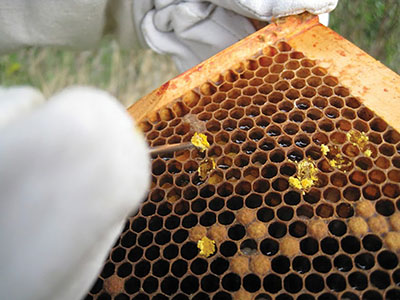
This is our twelfth “Notes from the Lab,” which means the column has been featured in ABJ for one year. That’s a shorter period of time than several neonicotinoid insecticides are known to be able to persist in soils. For example, if I applied a sufficient quantity of thiamethoxam to plants in my garden last year at this time, there’s a good chance I could dig up some soil from my garden today and find traces of thiamethoxam that are still there. And because thiamethoxam and other neonicotinoids are systemic insecticides, that means they can be taken up from soils and accumulated in plant tissues, including pollen and nectar. Which means the thiamethoxam I applied last year could potentially be in the pollen and nectar of plants that are blooming in my garden right now.
This topic has been of recent interest to scientists and policy makers due to the restrictions that are being placed on neonicotinoid usage in many parts of the world. The European Union decided in spring 2018 to impose broad restrictions on neonicotinoid usage, which follows up on partial restrictions that were imposed in 2014. Several Canadian provinces have issued their own restrictions on neonicotinoids recently, and many U.S. states have either imposed or are considering partial restrictions.
So, what do scientists and policy makers expect to see as a result of restrictions on neonicotinoid usage? The ramifications will certainly be complex, since different crop protection strategies, including usage of different insecticides, are likely to be used in place of neonicotinoids. But what about risk to pollinators from the neonicotinoids? Will that risk dissipate quickly? More specifically, when and where is risk from neonicotinoid exposure likely to change? This is the topic for our twelfth “Notes from the Lab,” where we highlight “Monitoring neonicotinoid exposure for bees in rural and peri-urban areas of the U.K. during the transition from pre- to post-moratorium,” written by Elizabeth Nicholls and colleagues and published in the journal Environmental Science and Technology [52:9391-9402 (2018)].
For their study, Nicholls and colleagues sampled pollen and nectar from experimental bumble bee colonies that they placed in several rural or suburban areas in the U.K. They sampled colonies multiple times during each summer over a period of three years: prior to the initial neonicotinoid restrictions (2013), during implementation of the restrictions (2014), and following restrictions (2015). They also sampled pollen and nectar from honey bee colonies in 2014 to see if similar patterns were observed for both honey bees and bumble bees.
Once the samples were collected, the authors took the pollen and nectar back to the lab and prepared them for pesticide residue analyses. These analyses were conducted via liquid chromatography and mass spectrometry, which allowed the researchers to separate the pesticides of interest (i.e., different neonicotinoids), then determine the amount of each of them. In total, Nicholls and colleagues analyzed 408 pollen and nectar samples from 222 bumble bee colonies and 15 honey bee colonies across the three years of the study. They screened for five different neonicotinoids in each sample – thiamethoxam, clothianidin, imidacloprid, acetamiprid and thiacloprid.
So, what did they find? Did the pollen and nectar contain neonicotinoids? Yes, a large portion of the samples from bumble bee colonies (40%) and honey bee colonies (68%) did contain neonicotinoid residues. For bumble bees, pollen was more often contaminated than nectar, and the total concentration of neonicotinoids was 10 times greater in pollen vs. nectar. For honey bees, neonicotinoids were found in about the same proportion of pollen vs. nectar samples, and the total concentration was about 3 times greater in nectar than pollen. While most concentrations were low (and therefore predicted to pose minimal risk to bees), some detections were high. For example, thiamethoxam was found at up to 38.8 ng/g, also known as parts per billion (ppb), in bumble bee pollen. If consumed, this level of thiamethoxam is predicted to kill ~40% of bumble bees within 48 hrs, as the LD50 for thiamethoxam is 0.005 ug/bee.
Did exposure to neonicotinoids change over the course of the study? This is where the study by Nicholls and colleagues really breaks ground. The authors found a substantial reduction in the concentrations of neonicotinoids that bees were exposed to in 2015 (post-restrictions) compared to 2013 (pre-restrictions) in rural agricultural areas. Thus, the study provides evidence that exposure to neonicotinoids was reduced as a result of restrictions….


